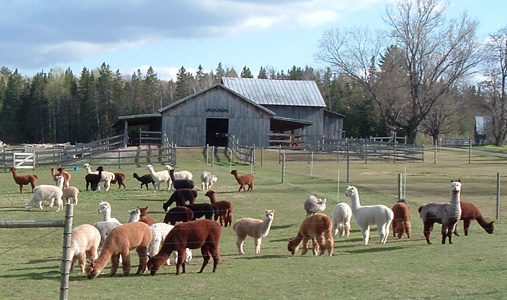A Brief History
Alpacas are members of the camelid family. There are four species of camel in South America: the domesticated species, the alpaca and the llama, and their wild ancestors, the vicuna and the guanaco. Alpacas and llamas were domesticated some 6,000 years ago by the ancient peoples of the altiplano, an inhospitable, treeless plain located at an elevation of about 14,000 feet in the mountains of Peru, Bolivia and Chile. While llamas were raised mainly to be beasts of burden, alpacas were raised to be producers of fine, luxury fiber in an assortment of colors. Together, the alpaca and the llama provided not only the food, fuel, clothing and transportation for the Andean people, but were – and still are – central to their religion, traditions and daily lives.
During the time of the Incas, the use of camelid fiber was tightly controlled. Fine fiber and exquisite textiles were seen as a measure of the wealth of the Incas. Fiber use was determined, in part, by one’s status in Incan society; cloth made from llama or guanaco was worn by the common people, cloth made from alpaca was worn by high ranking officials and cloth made from vicuna was reserved for use by the nobility. Commoners caught with vicuna fiber faced the death penalty.
When the Spanish conquered the Incan civilization over 400 years ago, thousands of years of strictly regulated animal husbandry and selective breeding were disrupted and most of the population of alpacas and llamas destroyed. The remaining native herders and their animals survived only because they were so well adapted to living in the harsh environment of the altiplano.
In the mid-1860’s, the value of alpaca fiber was recognized by Europeans. Eventually, this led to the British involvement with the mills in Peru and international recognition of alpaca as a luxury fiber.
Alpacas were first imported into the United States in 1984 and are being raised successfully in all areas of the United States.
Alpaca Facts
- Alpacas produce one of the world’s most luxurious fibers and come in more colors than any other fiber-producing animal. They are shorn annually without harm to the alpaca.
- Alpacas have padded feet and are gentle on the land. They prefer to graze on tender grasses and clip them off rather than pull them up by the roots.
- Alpacas are modified ruminants that convert grass and hay to energy very efficiently and, therefore, eat less than most livestock.
- Alpacas deposit their bean-like droppings in communal dung piles, controlling the spread of parasites and making pasture clean-up easy.
- Alpacas are non-aggressive and fairly easy to handle. They have no horns, claws or hooves. Adult alpacas generally weigh from 110 to 185 lbs.
- Alpacas give birth to one baby (cria) per year. Twins are extremely rare. The gestation period is approximately 335 to 355 days.
- Alpacas have a life expectancy of 15 to 20 years.
- Alpacas are intelligent, quiet and easily trained to halter and lead.
You can access educational articles about alpacas and their care at AlpacaAcademy.com.


